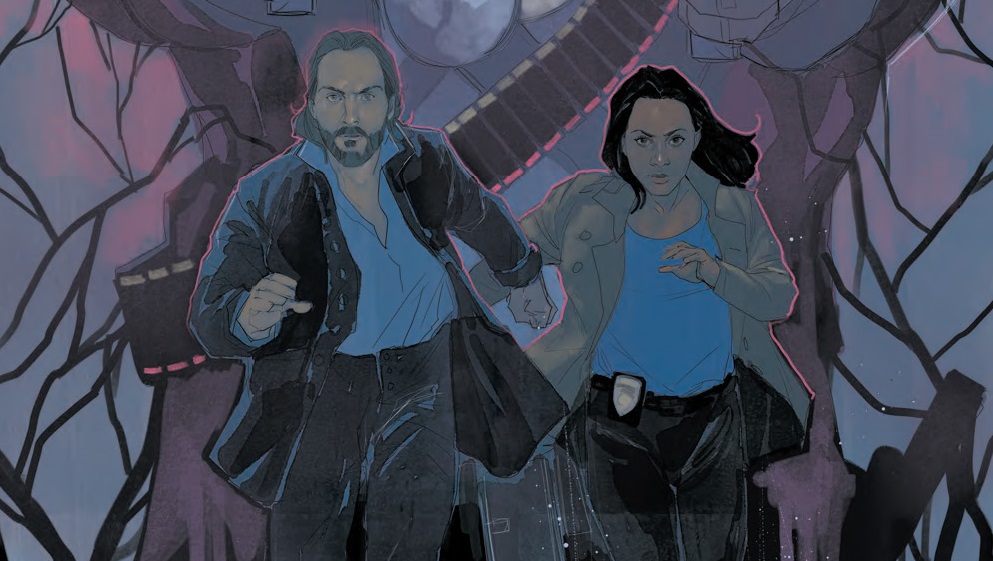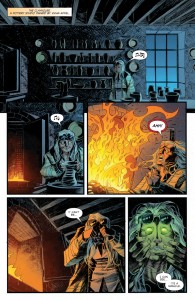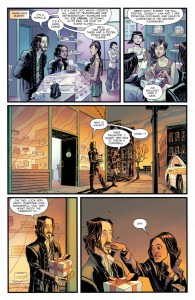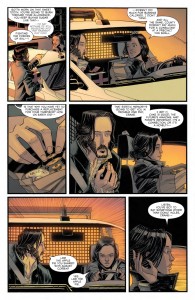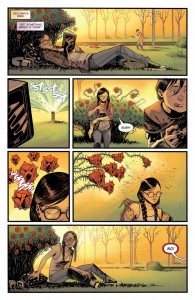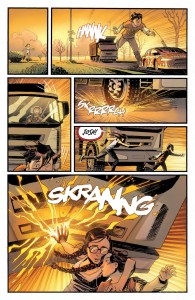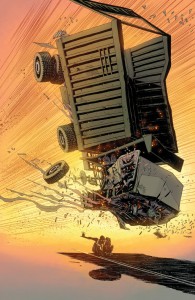In the wake of New York Comic Con, Deadshirt staff writer Christina Harrington sat down with comic book writer Marguerite Bennett, known for her work at DC, Marvel, and BOOM! Studios, to discuss her work on the new Sleepy Hollow book based on the hit FOX horror series.
Christina Harrington: So I guess my first question to you would be, how fucking excited are you to be writing the Sleepy Hollow book?
Marguerite Bennett: You know what, you can go ahead and print this. (Laughs) I’m more excited to do Sleepy Hollow than any of my Marvel or DC work, because with that there’s, y’know, these seventy-five year legacies and so it’s a lot of pressure and a lot of iconography. Sleepy Hollow just gave me a ton of freedom, and just let me be this super hyper, giggly fangirl. (Laughs) It was this thing that I could text with my editor or text with Noelle [Stephenson, who writes and draws the book’s backups] at all hours of the day and just geek out. That was super rewarding. There is no number high enough for my excitement.
CH: That’s fantastic. I know that you are a fan of the show and it’s hard to not be a fan of the show. It’s fun, the characters are rich and mulit-faceted and they really care about each other.
MB: Yeah.
CH: And I think that comes out in this issue especially. The interactions between Ichabod and Abbie in the beginning of the issue, like where she teases him about how much sugar he eats. We get these great interactions between Ichabod and Abbie in this first issue, but are we going to see the rest of the cast? Or will this be an Ichabod and Abbie-focused series?
MB: Oh, absolutely. What we wanted to do was to expand out with each issue of the comics. So, these issues fall within the episodes from the first season. The first issue comes pretty early, shortly after the Witches of Abaddon in “Blood Moon,” and as they gain more allies, as Jenny becomes a bigger part of it, as Frank is introduced to the craziness of this world, and the second issue brings them in a little bit. The first two issues, one and two, are stand alone, and the second two issues, three and four, are a two-part finale, essentially. And the two-part finale is an ensemble story. We’ve got Henry and Andy–we’ve got everybody there. (Laughs)
CH: I love your use of the Maiden, the Mother, and the Crone in this issue, and I was wondering–so a lot of your work feels very fairy tale-esque to me, especially the issue of Batgirl that you wrote. That felt like a dark, modern fairy tale, and Sleepy Hollow has always felt like an American fairy tale to me. In that context, what was your approach to writing the monsters in this series?
MB: Well, that’s part of my, I guess, natural aesthetic. Before I got picked up and put into superhero writing, my background was all prose, and I have a major tendency, uh–not to retell fairy tales, not to retell very familiar stories from a different perspective. I wanted new ones. I wanted new ones, but in that vein. The same eeriness and the grandeur, and the sing-song quality of it. And even though they’re new, that these legends could feel just as old and just as believed in. That sort of Southern-Gothic Americana was perfect for Sleepy Hollow, and was, I think, one of the reasons why I responded so strongly to the show when it first came out. So I rewatched the entire series when I was working on my pitches.
CH: I was going to ask what kind of research went into writing for this project.
MB: I took two days and marathoned the hell out of it! (Laughs) I went over it with a fine toothed comb. I wrote down lines that stuck out to me. When there were flashes through Corbin’s files, that’s where the statistic about the number of witches that had been executed [in Sleepy Hollow] came from. It was just a tiny snippet of dialogue. Or things I noticed in the bakground of scenes–I applied a lot of the obsessive fangirl love I would have had if I were still in high school when this came out and I wanted to write fanfiction with my friends during lunch break. (Laughs) It was the same skillset.
CH: I think that was a good approach! (Laughs) It was obviously successful.
MB: And then I filled it out with my knowledge of mythology, and with my knowledge of what myths are popular in–well, because I didn’t want it to be a cipher, I didn’t want to do a Jersey Devil episode. But I did want us to get that same feel out of it. With my natural inclinations and the raw data they gave me, I was just like [laughs evilly]. Cackling evilly, steepling fingers.
CH: The fairy tale qualities of this issue do have that depth, that grandeur like you were saying, but it also feels new, because America isn’t that old. I dig the fairy tale feel of this book, and it feels like it would fit tonally within the pantheon of episodes that we’ve seen so far on the show. Especially because the show relies on these weird, literary creatures like the Franklinstein monster a few weeks ago.
MB: I do want to say though, that as far as that goes, we often get the idea that America isn’t that old and we don’t have that many American traditions, but one of the things that I really enjoyed about the show is the fact that they brought in the Native American mythology and the Native American monsters. It’s not like there was nothing here and then suddenly a bunch of European traditions came in, it was that these things have grown together. It was the co-mingling of these stories, so you get overlap, you get reinterpretation. It was something that I really admired about the show.
CH: In that vein, is there any specific monster that’s already appeared on the show that you’d love to bring into this sandbox and write for?
MB: I loved the Golem and…and you know what? I’m going to err on the side of caution. I’m not going to say shit. [Laughs]
CH: So spoilers, then? Alright. I like that these take place during the first season, that there’s more to mine there.
MB: The first and second issues, though they are stand alone issues, they will feed into each other. The first one is the biggest blank slate, but the second one you start to get hints of what’s coming in the finale. The first one has an aspect that influences the villain in the second issue, and then the villain in the second issue used what had influenced him to create something in the third and fourth issues. They can be stand alone, but if you read all of them you get the complete picture and you can better understand the growing momentum that finally created our Big Bad.
CH: I like how cryptic you’re being. (Laughs)
MB: It’s my favorite thing. Evil Marguerite.
CH: So you’ve written for Marvel and DC before, for characters that have so much history behind them, but in the sense of Sleepy Hollow, it’s a very different kind of history. It’s a TV show and you’re translating it into a comic book. What was your process behind writing this series?
MB: One of the things that I love about comics is how unrestricted you are. I remember seeing–back when I still watched Dr. Who–Neil Gaiman had done an episode and he wrote about the process. He said that for Dr. Who, like many sci-fi and adventure television shows, you had to be aware while writing your script that you could either have a CGI-heavy show or a prosthetic and costume-heavy show. That the budget did not allow for both. And so you had to design your story to the limits of the special effects. Whereas in comics, you’re limited only by how much your artist will put up with. (Laughs) And I am so blessed to be able to work with Jorge [Coelho], and Tamra [Bonvillain], and Noelle [Stevenson], and Dafna [Pleban], who brought us all together.
I love body horror, so there’s a lot of body horror in a lot of my stuff and there’s a lot of body horror in Sleepy Hollow. I just wanted to do something, like, nutso. [Laughs] And Sleepy Hollow does amazingly creepy things. Just the smallest details, like the They Who Speak As One and their wet, gnashing teeth. Which was just like, ooh that’s good. It’s so subtle and it’s good. With that, I was free to be bombastic and free to bring in the spectacle of comics. There’s a scene coming in our second issue where the panels get increasingly tighter over a few pages. Everything just gets smaller and more detailed and more detailed, and then we wind up just plunging into this splash page that’s part of this Americana and twisted folklore thing and I hope you enjoy it.
CH: I’m looking forward to it.
MB: Cheers! We’re not trying to just do an episode of Sleepy Hollow on paper. It’s not like we’re storyboarding. I wanted it to be like, we’re using this medium to specifically do something that wouldn’t translate to a novel. Maybe it wouldn’t even translate to the screen. We want to give fans the stories that they love, but to bring it to them in a way that’s entirely unique to comics.
CH: I think that comes through in this issue, especially in the art. These aren’t tracings of the actors, they’re stylized. These are characters.
MB: Jorge is so talented and he brings so much liveliness and the suggestion of movement even to the littlest things. This is part of that fangirl scrutiny, but when I was writing the script I added these notes, like–Ichabod has very particular gestures, and when he’s making a point it isn’t the American finger pointed at your chest. He has these large but spindly and delicate gestures, even when he’s handling objects. Whereas Abbie can say absolutely anything by saying nothing at all, with just a look or an expression. She’s very controlled and precise with how she expresses herself at others, how she looks at others, especially her eyes. If you want to amp something up, look to Ichabod’s hands and Abbie’s eyes. And Jorge did that, just gorgeously. He’s fantastic and I could not be happier to be working with him.
CH: I love the Noelle Stevenson back-up.
MB: She’s the best.
CH: I’m curious, how did the back-ups come into being?
MB: Dafna, Noelle, and I originally met back at Baltimore Comic Con 2013. So I had about two issues to my name, and Dafna had sort of discovered me through the controversy behind the Lobo Villain’s Month issue. We all got to talking and I had just seen the pilot during San Diego Comic Con, and we all sort of discovered that we all loved this TV show. So whenever the three of us were in a room we were gushing over the characters or theorizing about what was coming, and really having a fun time with it. The fact that it was fun and not work was, you know, a huge part of the appeal. So we had so much enthusiasm that Dafna wound up asking how I would feel about pitching for the series if they could work out a deal with Fox. And I was like, I would be breaking the sonic barrier with how quickly I would say yes. (Laughs) And they did end up working out a deal with the license, and I ended up pitching, and they went with my pitch.
The stories with BOOM! are twenty-two pages and I always ask my editor that because I have to know the page number; I know exactly how much space it’ll take me to tell something. So I was like, “I will create a twenty-two page story.” A few weeks into it, Dafna was like “How would you feel if we brought Noelle in on back-ups?” And I was like: “Give her as many pages as you want.” I was willing to give up pages of the main story if it meant bringing Noelle in on it. In addition to being a wonderful person and such a talented artist, she’s such a big part of the fan community. And being able to share the positivity and enthusiasm that people have for what they enjoy, in Sleepy Hollow in particular, was important. I actually went back and looked at her drawings on Tumblr before I wrote out my pitches.
CH: Thank you so much for talking with me. Before you go, is there anything else you want to tell us about the upcoming issues of Sleepy Hollow?
MB: They’re only going to get crazier. They’re going to get crazier in different ways. The first story is a story of magic, the second story is a story about a man, and the third is a story about a machine. (Laughs) Yeah, we’re only getting crazier from here.
The first issue of Sleepy Hollow is in comics shops and online tomorrow.

